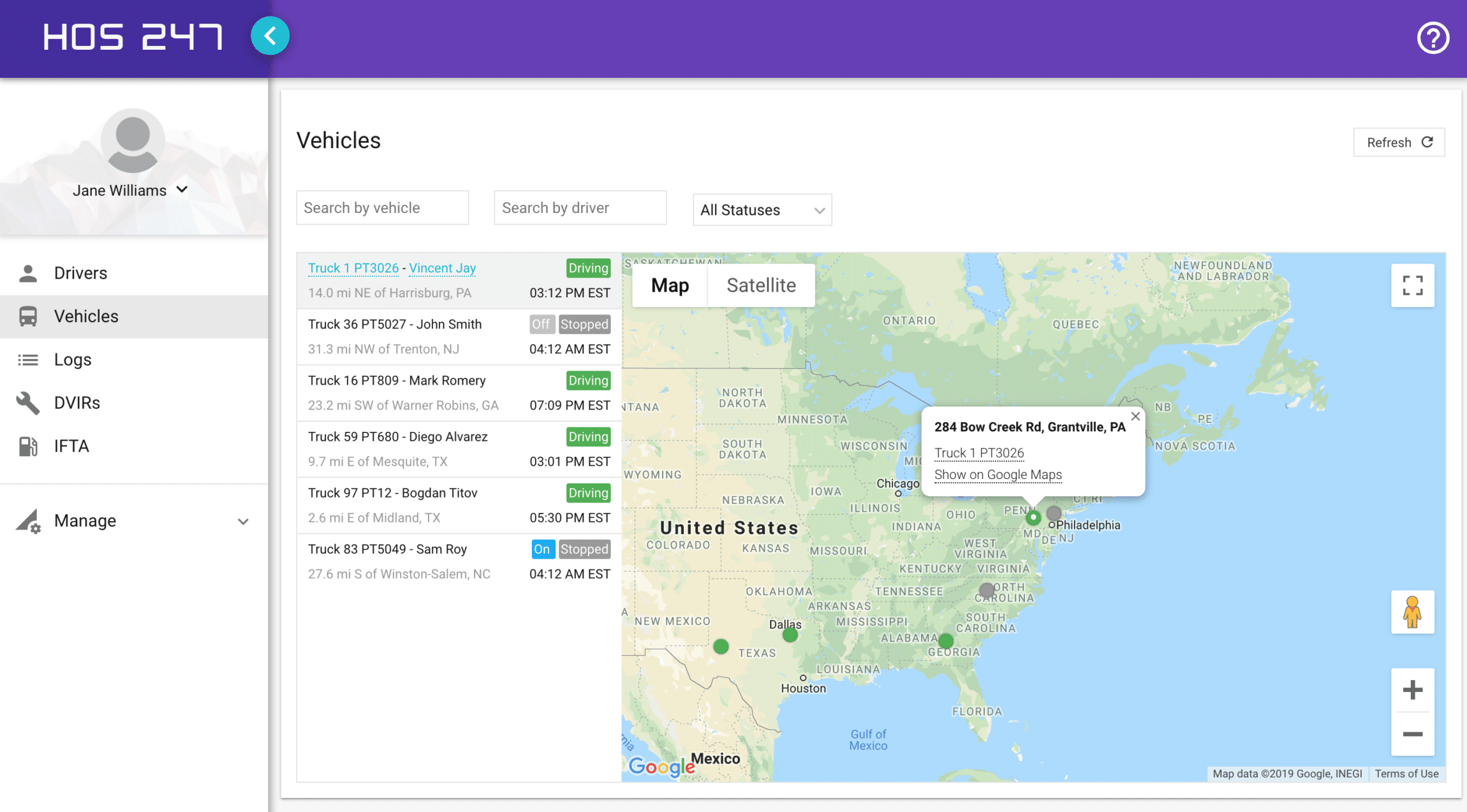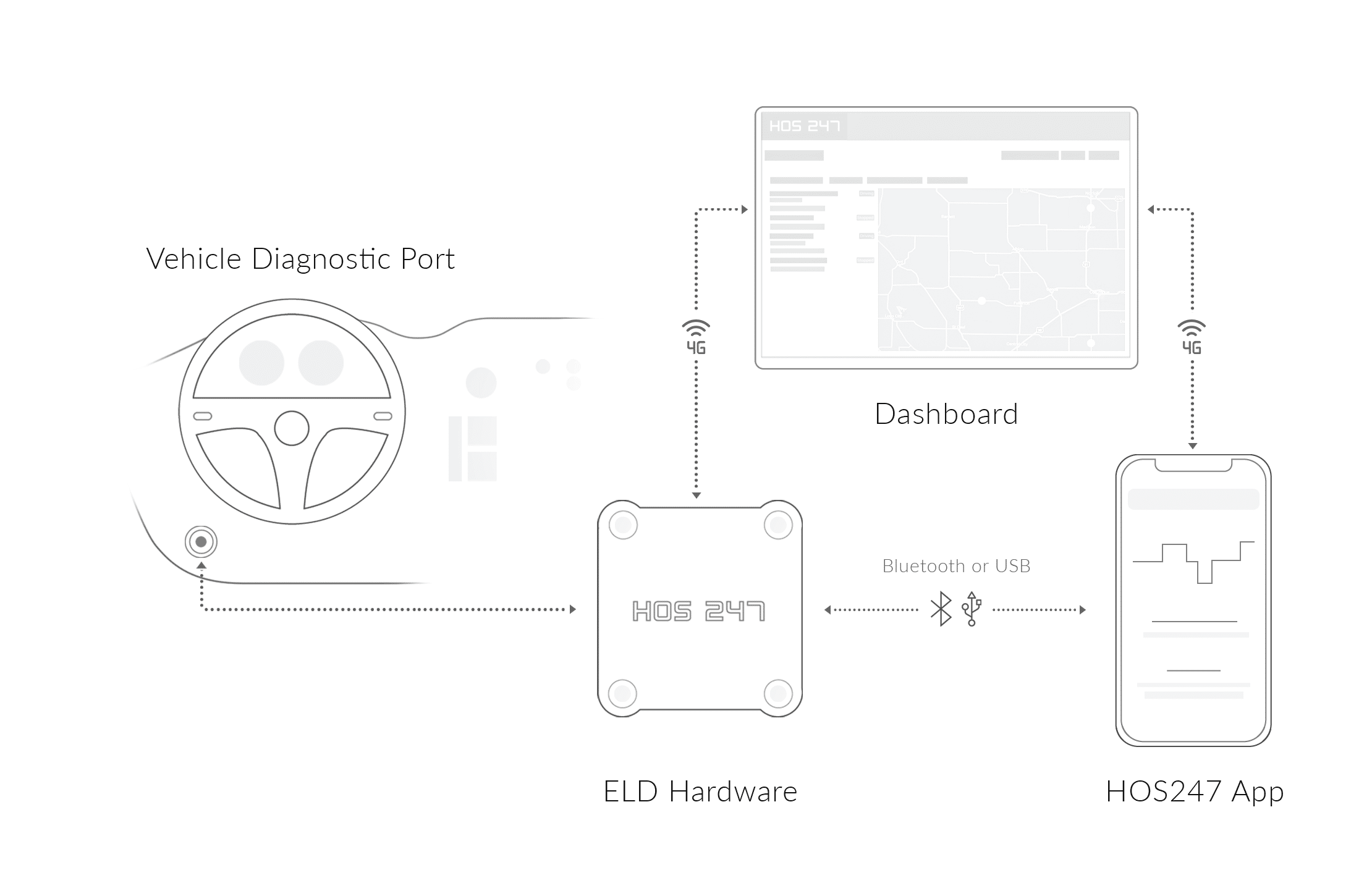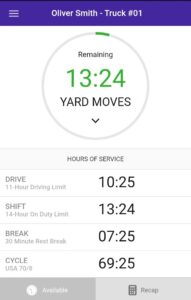Transform Compliance Into A Competitive Advantage with Driver Log Software in Canada
In the world of trucking, accurate record-keeping isn’t just good business practice — it’s the law. For decades, truck drivers filled out paper logbooks, recording their working hours, rest periods, and miles traveled. The switch from paper logs to driver log software is a notable shift in how compliance, safety, and efficiency are managed on Canadian highways.
The importance of accurate driver logs cannot be overstated. They officially record a driver’s working hours and help make sure federal rules are followed. These logs protect both drivers and carriers during inspections and audits and provide useful information to improve operations and save money. Today, they can integrate with vehicle diagnostics, GPS tracking, and dispatch operations to give a clear view of every aspect of transport operations.
In this article, we’ll explore driver log software from its basic functionality to extra features, compliance benefits, and business advantages. For both small operators looking to meet Canadian electronic logging device (ELD) mandate and large fleets seeking better efficiency, understanding your options is crucial.
Do you have any questions? Talk to ELD Advisor: 650-405-3372 or Request Callback
What Is Driver Log Software?
Essentially, it is the digital replacement for paper logbooks that used to sit in the front of every truck cab. This technology automatically records a driver’s hours of service (HOS), duty status, and driving time by syncing with the vehicle’s engine. Unlike paper logs that rely on manual entries, modern ELD systems generate accurate, tamper-resistant records that are easy to access during roadside inspections or audits. Some systems can also integrate with GPS or telematics tools for added features like route tracking.
Logging software has evolved considerably since the early days of electronic logging. What started as basic HOS recording tools are now complex solutions that handle everything from pre-trip inspections to fuel tax reporting while having the core functionality of automated driver logs.
There are three main jobs the software has: ensuring compliance with federal regulations, improving operational efficiency, and enhancing safety on the road. It automatically records hours of service so drivers don’t break rules that could cause fines or being placed out of service.
When comparing paper logs to digital solutions, the advantages of automation become clear. Paper logs were time-consuming and prone to accidental miscalculations or deliberate falsification. With driver log software, key data like drive time and location is recorded automatically using engine connection and GPS, making records more accurate and reducing the burden on drivers to track everything manually.
It’s important to understand that the Canadian ELD mandate requires a complete electronic logging system composed of both software and hardware components. The hardware piece physically connects to the truck’s engine control module (ECM), gathering data about engine power status, vehicle motion, miles driven, and engine hours. The software then uses this data to create easy-to-understand logs that follow Transport Canada rules. This hardware-software system keeps the data accurate and harder to alter than paper logs. For drivers and fleet owners, this means their records will hold up during inspections and audits.

Key Features of Driver Log Software
Today’s driver logs go far beyond simple hours tracking. Modern systems pack in features that make life easier for drivers on the road and fleet managers back at the office. Let’s break down what makes these digital tools so valuable.
Ease of Use
Even the most feature-rich software can be less satisfactory than expected if drivers struggle to use it. That’s why leading systems are designed with easy-to-use interfaces that require little training, often featuring simple touchscreens and clear visuals for driving status, available hours, and warnings.
Office staff benefit from user-friendly dashboards that make it easy to access compliance reports, check driver availability, and view fleet metrics. The software should be simple enough for anyone to learn in just a few days.
Real-Time Violation Alerts & Warnings
One of the most helpful features is real-time alerts that warn drivers as they approach their driving or on-duty limits. Instead of constantly calculating remaining drive time, drivers receive clear alerts as they near their 11-hour driving limit, 14-hour on-duty maximum, or 60/70-hour weekly limits. This helps drivers find parking before breaking the rules and helps dispatchers assign loads more efficiently, reducing the risk of violations and scheduling problems.
Driver Vehicle Inspection Report (DVIR) Integration
Safety doesn’t start and end with driving hours. That’s why driver logs software helps with pre-trip and post-trip inspections by letting drivers create and edit digital inspection reports instead of paper forms. This makes sure inspections are done properly and any problems are recorded.
When problems are found, the system can quickly alert maintenance teams and track the repair process until issues are resolved. This digital trail of inspections and repairs protects fleets during compliance reviews and shows that maintenance is taken seriously.
Real-Time GPS Tracking
Modern systems track exactly where trucks are at all times. The GPS integration, which is an extra feature, provides live updates on vehicle location and driver activity, allowing dispatchers to monitor progress without constant check-in calls. For drivers, this means fewer interruptions and better support when dealing with detours or traffic issues.
When a customer calls asking about their delivery, fleet managers can provide accurate ETAs based on actual location data rather than rough estimates. This location tracking also creates a verifiable record of routes taken and stops made, which is useful for billing disputes or performance analysis.
Choosing the Right Driver Log Software
Finding the right system for your operation isn’t a one-size-fits-all situation. With dozens of options on the market, several factors must be considered beforehand. Let’s explore what to look for in a solution that will serve your fleet for years to come.
Important Selection Factors
Whether you’re running three trucks or three hundred, you need a system that can grow with your business. Consider these factors:
- Ensure it’s easy to add drivers and vehicles as your fleet expands.
- Look for tiered pricing that adapts to your evolving operational needs.
- Avoid outgrowing your software and having to reimplement just as your team gets comfortable.
The software doesn’t exist in a vacuum. When it comes to integration and compatibility:
- Make sure your ELD system integrates smoothly with existing systems (dispatch, accounting, maintenance, etc.).
- Maintain a seamless data flow for better efficiency and a clearer operational overview.
Evaluate hardware requirements:
- Some systems require proprietary, expensive-to-replace devices.
- Others allow BYOD (bring-your-own-device), running on standard tablets or smartphones, giving you more flexibility.
In terms of support and trial options, consider these points:
- Even user-friendly software can create occasional confusion, so having solid customer support is a must.
- Ensure every day support availability if your operations need it.
- Multilingual support is necessary if your driver base is diverse.
- Don’t commit blindly — look for trial periods or live demos to test the interface and functionality beforehand.
Last, but not least — focus on regulatory compliance and updates:
- HOS regulations change, and your software must keep up.
- Ask vendors about their responsiveness to Transport Canada updates.
- A strong update track record ensures ongoing compliance and reduces risk.
With these considerations in mind, choosing the right vendor should be easier. When you choose a system that’s flexible, easy to integrate, well-supported, and built to keep up with the rules, you’re setting yourself up for fewer headaches down the road and smoother day-to-day operations for everyone.

Standalone Solutions vs. Integrated Fleet Management Systems
Opting for a standalone ELD solution or investing in a comprehensive fleet management system with integrated logging capabilities is often a tough choice. Let’s dive deeper into these options.
Standalone solutions handle HOS compliance and little else. They’re typically more affordable upfront and may offer simpler interfaces with less training required. For small fleets primarily concerned with meeting the Canadian ELD mandate at minimal cost, these can be attractive options.
Integrated fleet management systems, on the other hand, have additional features like asset tracking, fuel management, maintenance scheduling, and advanced analytics. While they cost more, they usually deliver greater long-term value by connecting previously siloed aspects of your operation.
The right choice depends on your specific needs. A small carrier with straightforward routes might thrive with a standalone solution. Meanwhile, a larger operation with complex logistics could use the additional capabilities of an integrated system. Remember that it’s a tool you’ll use every day, so choose solutions that are easy to use for your team.

Benefits of Using Driver Logs Software
Driver logging software delivers advantages that go beyond meeting regulatory requirements. Here’s how it adds real value for both fleets and drivers:
- Improved compliance. The software automatically tracks hours of service, so drivers don’t have to memorize rules or do manual calculations. It sends alerts to prevent violations and ensures logs are accurate and ready for inspections.
- Higher productivity. What used to take up time and manual calculations with paper logs now happens automatically. Time saved from this is just one way logs boost productivity. They also reduce errors and admin work, streamline roadside inspections, and improve communication between drivers and dispatch. Real-time data helps catch issues early and supports better routing and scheduling, all of which add up to more efficient operations and more time spent driving.
- Cost savings. The software helps prevent costly HOS violations, which can lead to penalties and drivers being placed out of service. It also tracks fuel use and idle time to cut waste, saving money on fuel. Additionally, many insurance companies in Canada offer discounts to fleets using ELDs because they improve safety.
- Better safety. ELD systems help improve safety by ensuring drivers take required rest breaks and stay within legal driving limits, reducing fatigue-related risks. Many systems also include GPS tracking, which helps locate drivers quickly in emergencies or unexpected situations. While basic ELDs focus on HOS compliance, some providers offer integrated features like speed monitoring or harsh braking or speeding alerts that fleets can use to coach drivers and reduce unsafe behavior.
- Maintenance support. Modern software can track engine issues, alert maintenance teams, schedule preventive care, and keep detailed repair records. This helps catch small problems early, reducing breakdowns and extending vehicle life.
By making compliance easier, saving time, improving safety, and helping maintain trucks, driver logging software is a powerful tool that benefits everyone on the road.
Route Optimization and Idle Time Reduction
Driver log software provides valuable data that can streamline operations and cut waste. The detailed trip logs capture information about:
- Routes taken and possible better alternatives.
- Time spent at customer locations for loading and unloading.
- Traffic delays on regular routes.
- Unplanned stops or route changes.
Fleet managers can use this information to spot problems and find solutions. For example, if certain locations cause long delays or some routes are always congested, they can negotiate better appointment times or plan new routes. The software also helps cut down on fuel waste by tracking when and where trucks idle too long. This lets fleets create policies and training to reduce unnecessary idling and save fuel.
Operational Efficiency Improvements
The trip log component of driver logging software helps operations run smoother. Fleets can access detailed trip summaries that make billing and payroll easier. If there’s ever a dispute about delivery times or hours worked, the digital logs provide clear proof.
The software also helps spot patterns in driver behavior or vehicle problems early. This lets managers fix issues before they become bigger problems. Using trip data, fleets can use resources smarter. For example, they might find some routes take longer than expected or that certain drivers work best with specific customers or types of freight.

HOS247: A Reliable Driver Trip Log Software Solution
With so many ELD providers out there, it’s important to choose one you can count on. HOS247 is built specifically for Transport Canada compliance, offering a reliable solution for fleets dealing with complex logging requirements.
HOS247 has earned its reputation by focusing on what really matters: making compliance simple while improving fleet performance. Our software covers all the necessary regulations while staying user-friendly and efficient.
What truly sets our solution apart is its practical design, developed with real input from drivers and fleet managers who face the daily challenges of the road and office. This means the system isn’t just built to meet standards on paper — it works reliably in the real world.
With HOS247, you’re not just getting an ELD. You’re gaining a partner committed to helping your fleet stay compliant, efficient, and ready for whatever the road brings. Here are the key benefits of our solution:
- Seamless integrations. HOS247’s driver trip log software doesn’t exist in isolation. It’s designed to work with other systems fleets rely on daily. The platform offers integration capabilities with popular dispatch software, accounting programs, and maintenance tracking tools. This gives you a clear, unified view of your fleet, helps teams work together more efficiently, and makes managing compliance and operations simpler.
- User-friendly software. For drivers, dispatchers and fleet administrators, HOS247 provides intuitive interfaces that show critical information at a glance. You can see driver status, available hours, locations, and compliance details in real time with no special training needed. This quick access helps keep the whole fleet on track and make smart dispatch decisions.
- Reliable hardware. HOS247 offers durable hardware components. This means fewer device failures, less maintenance, and reliable performance even in harsh conditions. Drivers can be confident that their compliance tools will work when they need them most.
- Multilingual support. We offer customer support in multiple languages, including English, Spanish, Russian, and Polish, making it easy for drivers from different backgrounds to get help in their preferred language. Our commitment to accessibility reduces frustration so that everyone using the system can enjoy their experience.
- No-contract options. While many ELD providers lock customers into long-term contracts, we offer flexible agreements including month-to-month options. This way, fleets can adjust their technology solutions as needs change.
HOS247 emphasizes values that resonate strongly with both drivers and fleet managers: simplicity and flexibility. Here’s how we bring this to life:
- Intuitive app experience. The driver app has a clean, simple design that helps drivers quickly log their status, check hours, and access inspection info without confusion or extra steps. There are no confusing menus, unnecessary features or distractions; instead, drivers can focus only on essential functions.
- Adaptability to regulatory changes. Trucking regulations often change, and our software is built to adapt quickly as Transport Canada requirements evolve. This flexibility protects fleets from the disruption and costly system upgrades when new rules come into effect.
- Technological readiness. Beyond regulatory changes, HOS247 stays current with technological trends. We incorporate emerging technologies and customer feedback to keep the platform current and valuable as the trucking industry advances.
- Easy log management. HOS247 allows users to easily edit driver vehicle inspection reports and time logs. Fleets can adjust user permissions and get maximum value from their investment.
By focusing on reliable performance, ease of use, and strong support, HOS247 offers more than basic compliance and more. With quality performance and smart design, our platform represents what fleets should look for in a software provider. For trucking companies seeking an ELD partner rather than just a vendor, we deliver a combination of compliance expertise and real operational value.
The Role of Driver Log Software in Reducing Driver Turnover
Driver turnover is one of the biggest challenges for transportation companies. With high annual turnover rates for many large carriers, retaining qualified drivers is as critical as maintaining vehicle fleets.
The financial impact of driver turnover is huge since each driver replacement means more spending through recruitment advertising, background screening, orientation programs, and training requirements. Beyond these direct expenses, losing experienced drivers disrupts operations: service quality drops, dispatching becomes harder, and safety can suffer as new drivers get used to routes and equipment.
With ongoing driver shortages in Canada, reducing turnover is more than just saving money; it’s vital to keeping the business running. Driver log software helps not only with compliance but also tackles this important challenge.

How Driver Logging Software Helps Tackle Driver Turnover
Switching from paper logs to automated solutions has changed how drivers work by cutting down on paperwork. This automation simplifies recordkeeping and reduces tasks that don’t involve driving. By handling HOS tracking automatically, the software lets drivers focus more on driving and less on administrative work.
Driver log software also helps keep a healthy balance between work and personal time. It accurately tracks hours to ensure drivers get the required rest and off-duty breaks. The pressure to meet deadlines may lead to drivers working beyond legal limits, harming their well-being. With electronic records, drivers can prove their hours, and managers can spot scheduling issues that cause fatigue or frustration. This shared accountability leads to more consistent schedules and protected personal time.
Modern driver log solutions are designed to make daily tasks easier by including features like clear displays of drive time and duty status, simple controls for status updates, automatic detection and recording of driving, limit alerts, and easy access to inspection documents. These features reduce tech challenges, which matters for drivers with different skill levels.
The data gathered from the software also gives managers clear insights into what affects driver satisfaction and turnover. For example, logs often show issues like routes that push drivers to their HOS limits, long wait times at certain customers, or scheduling that hurts work-life balance. With this information, managers can balance workloads, adjust customer appointments, offer fair pay for detention time, evaluate dispatcher performance based on retention, and reward safe and efficient drivers.

Conclusion
Choosing a quality provider is one of the most important decisions fleets can make when moving to digital driver logs. A well-built solution does more than check the compliance box — it becomes a key part of operations, helping fleets manage safety, reduce admin work, and keep drivers satisfied.
The right ELD provider offers not only the tools but the support and reliability needed to make the switch smooth. Modern software offers real-time data to stay ahead of issues before they become bigger problems. It streamlines compliance and daily tasks, improves safety, and helps fleets stay competitive.
While the investment can deliver quick returns, its real value lies in creating a foundation for long-term success. For this reason, exploring such tools is a key step for trucking companies seeking better efficiency and compliance in today’s environment.

I’ve co-founded, built and managed several transportation-related businesses. Now, I’m a founder and CEO of HOS247 – an AI Transportation Platform for trucking companies, freight brokers and other logistics operations. We are transitioning old-style operations to technology-advanced logistics entities and help them to grow their businesses. ELDs (electronic logging devices), fleet tracking and management 2.0 combined with AI-powered dispatch tools.












An ELD is an electronic logging device that keeps track of a driver’s driving hours and checks their record of duty status (RODS). It keeps accurate records by automatically updating a driver’s hours of service records. Once an electronic logging

GPS tracking systems for fleet management have become an essential tool in the Canadian trucking industry. They provide useful information about the fleet’s trucks, including real-time locations and vehicle diagnostics, allowing carriers to optimize deliveries, load assignments, and other essential

GPS tracking is an indispensable tool for fleet businesses as it provides managers with information about the real-time location of vehicles and other assets, helping motor carriers effectively monitor their fleets and optimize processes. Canadian truck fleet tracking uses Global